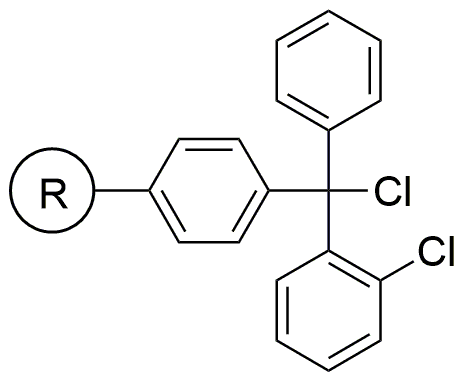2-Chlorotrityl chloride resin is widely utilized in research focused on:
- Solid-Phase Peptide Synthesis: This resin serves as a key support for synthesizing peptides, allowing researchers to create complex molecules efficiently and with high purity.
- Drug Discovery: In pharmaceutical research, it is used to immobilize various compounds for high-throughput screening, facilitating the identification of potential drug candidates.
- Organic Synthesis: The resin acts as a versatile tool in organic chemistry for the preparation of diverse chemical libraries, enabling rapid prototyping of new compounds.
- Bioconjugation: It is employed to attach biomolecules to surfaces or other molecules, enhancing the development of targeted therapies and diagnostics in biotechnology.
- Environmental Applications: The resin can be used in the extraction and purification of pollutants from environmental samples, aiding in the assessment and remediation of contaminated sites.
General Information
Properties
Safety and Regulations
Applications
2-Chlorotrityl chloride resin is widely utilized in research focused on:
- Solid-Phase Peptide Synthesis: This resin serves as a key support for synthesizing peptides, allowing researchers to create complex molecules efficiently and with high purity.
- Drug Discovery: In pharmaceutical research, it is used to immobilize various compounds for high-throughput screening, facilitating the identification of potential drug candidates.
- Organic Synthesis: The resin acts as a versatile tool in organic chemistry for the preparation of diverse chemical libraries, enabling rapid prototyping of new compounds.
- Bioconjugation: It is employed to attach biomolecules to surfaces or other molecules, enhancing the development of targeted therapies and diagnostics in biotechnology.
- Environmental Applications: The resin can be used in the extraction and purification of pollutants from environmental samples, aiding in the assessment and remediation of contaminated sites.
Documents
Safety Data Sheets (SDS)
The SDS provides comprehensive safety information on handling, storage, and disposal of the product.
Product Specification (PS)
The PS provides a comprehensive breakdown of the product’s properties, including chemical composition, physical state, purity, and storage requirements. It also details acceptable quality ranges and the product's intended applications.
Certificates of Analysis (COA)
Search for Certificates of Analysis (COA) by entering the products Lot Number. Lot and Batch Numbers can be found on a product’s label following the words ‘Lot’ or ‘Batch’.
*Catalog Number
*Lot Number
Certificates Of Origin (COO)
This COO confirms the country where the product was manufactured, and also details the materials and components used in it and whether it is derived from natural, synthetic, or other specific sources. This certificate may be required for customs, trade, and regulatory compliance.
*Catalog Number
*Lot Number
Safety Data Sheets (SDS)
The SDS provides comprehensive safety information on handling, storage, and disposal of the product.
DownloadProduct Specification (PS)
The PS provides a comprehensive breakdown of the product’s properties, including chemical composition, physical state, purity, and storage requirements. It also details acceptable quality ranges and the product's intended applications.
DownloadCertificates of Analysis (COA)
Search for Certificates of Analysis (COA) by entering the products Lot Number. Lot and Batch Numbers can be found on a product’s label following the words ‘Lot’ or ‘Batch’.
*Catalog Number
*Lot Number
Certificates Of Origin (COO)
This COO confirms the country where the product was manufactured, and also details the materials and components used in it and whether it is derived from natural, synthetic, or other specific sources. This certificate may be required for customs, trade, and regulatory compliance.


